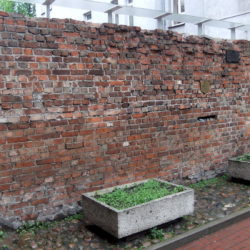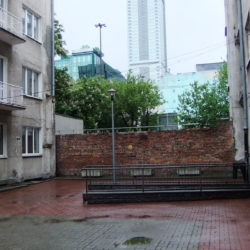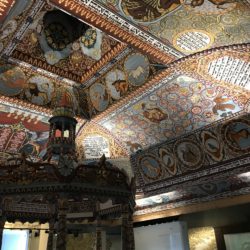I have visited the remains of the Warsaw Ghetto and Jewish life in Warsaw before 1939 on several occasions, and here I show some photos from my large collection.
In the ghetto at the end of 1939, Jews from Warsaw, most Jews from Poland and many railroad transports with Jews from Germany were crammed into the ghetto, alltogether 1.3 million people. Until 1943, 500,000 were transported like cattle to the SS concentration camp Treblinka and murdered there. 1943 saw the largest Jewish uprising against the Nazis, after which the Nazis completely destroyed the Great Synagogue and the Jewish quarter.
After World War II, the Communists built the modern Warsaw above it, and today there are high-rise buildings on the grounds of the synagogue. Two of the best-known preserved small fragments of the ghetto belonged to the so-called “small ghetto” and are located in the courtyards of buildings at Ulica Sienna 55 and Ulica Złota 62 (ulica is the Polish word for “street”).
- 55 Sienna Street Ghetto Warsaw
- 55 Sienna Street Ghetto Warsaw
- 55 Sienna Street Ghetto Warsaw
- 55 Sienna Street Ghetto Warsaw
- 62 Złota Ghetto Warsaw
- 62 Złota Ghetto Warsaw
In addition, I also add photos of the remains of the tram through the ghetto in the Ulica Ghetto, as well as the Nożyk Synagogue of Warsaw, which was also part of the small ghetto and survived as a depot half destroyed. Originally built in 1898–1902, it was rebuilt and restrained in 1977–1983.
- Original rails Ghetto Bohaterow Getta Street Warsaw
- Original rails Ghetto Bohaterow Getta Street Warsaw
- Old Synagogue Warsaw
- Old Synagogue Warsaw
- Old Synagogue Warsaw
The POLIN Museum of the History of Polish Jews (Polish: POLIN Muzeum Historii Żydów Polskich), which was opened in 2013 and 2014 – partly built with donations from the Federal Republic of Germany – is an excellent documentation and will be supplemented in 2023 by the Ghetto Museum, which is currently under construction.
- Holocaust Museum Warsaw
- Holocaust Museum Warsaw












